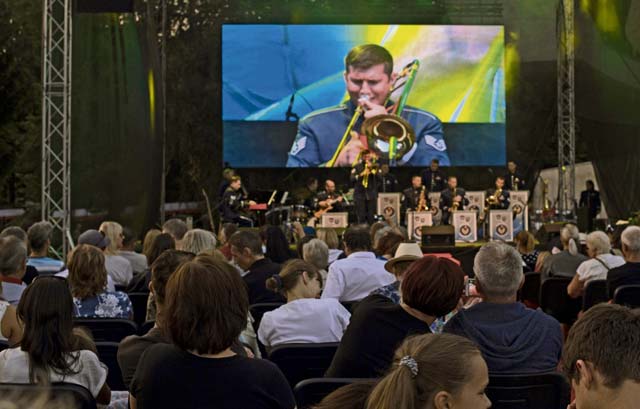BRATISLAVA, Slovakia — On Aug. 29, 1944, the Slovak army and resistance began an uprising against the pro-Nazi Slovak government of the time and the German occupation of their country.
They were successful in liberating their homeland and held annual celebrations to commemorate the event. For the 73rd anniversary, the U.S. Air Forces in Europe jazz band, The Am-bas-sadors, were invited to play two concerts for the occasion.
“It’s actually a series we’ve been doing for a number of years now, and we’re very happy to support it year after year,” said U.S. Air Force Master Sgt. John Dawson, noncommissioned offi-cer in charge of USAFE jazz band. “This is the first time in a while the jazz band has done it. It was really interesting to be sharing the stage with a couple Russian folk ensembles and different Slovak groups that were there.”
Causing toe-tapping, head bobs, and dancing, the jazz band performed at the Museum of Slovak National Uprising in Banská Bystrica, Slovakia, on Aug. 29 and in the nation’s capital, Bratislava, on Aug. 30.
“We have a very good relationship with the U.S. Embassy and they offered to us the U.S. Air Force band,” said Boris Vigaš, Museum of Slovak National Uprising director of guides. “It’s very popular. We want to have diversification, so we had folk groups, jazz, folk, rock. We want to have something for everyone because there are generations of people.”
The jazz band serves to increase cultural ties and enhance the people-to-people relationships between the U.S. and Slovakia.
“Music bridges cultures in a way that nothing else can,” Dawson said. “Especially in Slovakia where we had a definite language barrier that was immediately broken down once we started playing music. The difference in the disposition of the people from the beginning of the show to the middle to the end was remarkable. You could see it on their faces. At the end they want to come up to us and take photos and give their adulation, and they find a way to do it through the language barrier.”
The band played jazz music from the 40s and 50s era, and was received with enjoyment by the audience.
“You don’t need to speak English; you can understand jazz and music,” Vigaš said. “It’s a universal language and element that connects cultures. It’s great to see people react to the music. It doesn’t matter if it’s a folk group from Russia or a jazz band from the U.S., there were children dancing. It’s fun to listen to music and it’s great.”
Being a part of the annual celebration was a rewarding experience for many of the band members.
“The music itself is an exciting thing, and being able to feel the response the audience has is really the most special thing about going and visiting places like this,” Dawson said. “When we were there for the celebration, it was very humbling to be a part of their one for such a dignified day for them in their culture. For them to invite us to be a part of that, it’s just humbling and an honor to be a part of their tradition.”
“Having the ambassador come up and speak to the audience in the Slovak language I think had a direct connection with them immediately,” he continued. “It created a sense of commonality and trust with the nation’s people and it’s going to be something we continue to build on for many years.”
The U.S. provided supplies and support to Slovakia during their uprising, and aided them in pushing out the German occupation.
“I want to advise all people from the U.S. to visit the Museum of Slovak National Uprising, because it’s also a part of their history,” Vigaš said. “There was an American mission here in the uprising. We are very proud that’s a part of history that connects Slovak and American people.”
Looking back into history, people can learn and grow based off the actions of those who came before them. The U.S. and Slovakia continue to strengthen their relationship, and the USAFE jazz band has a unique opportunity to bring the two cultures together through the power of music.



